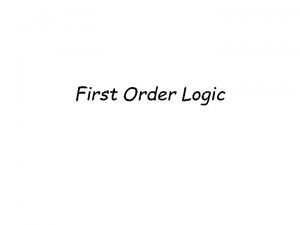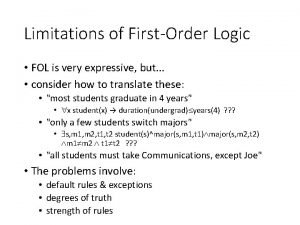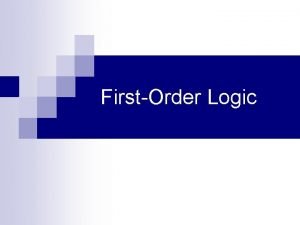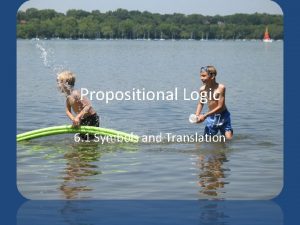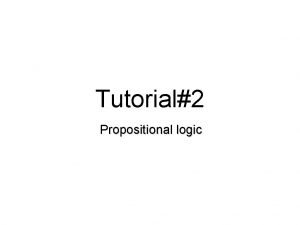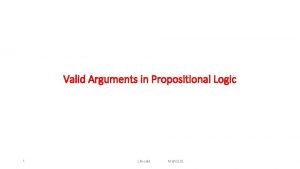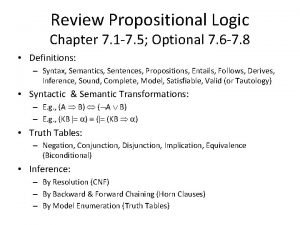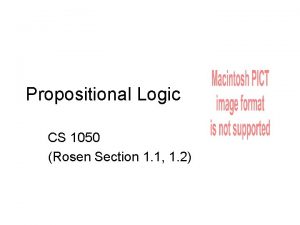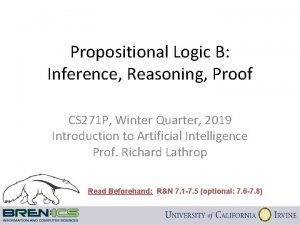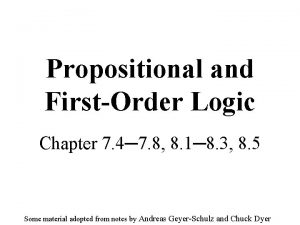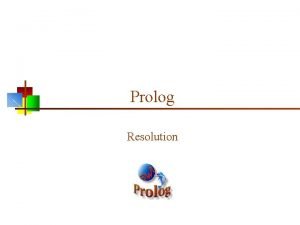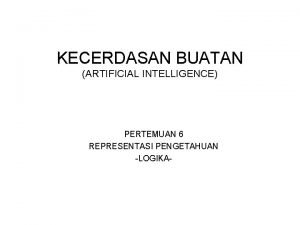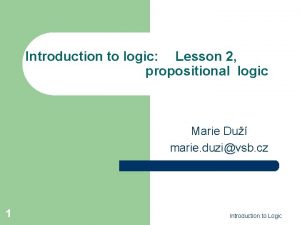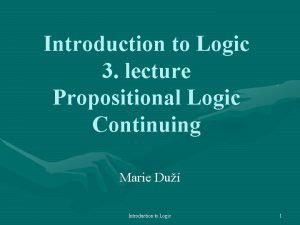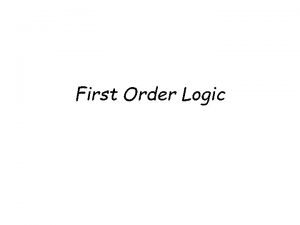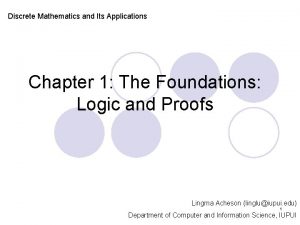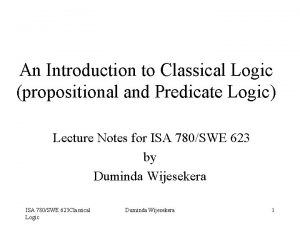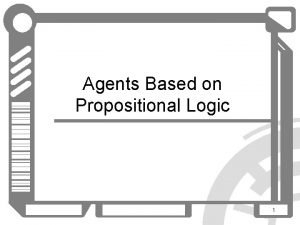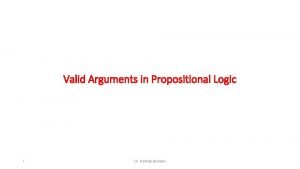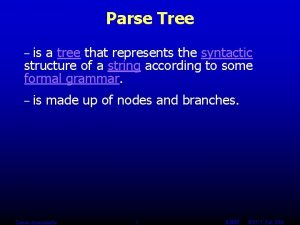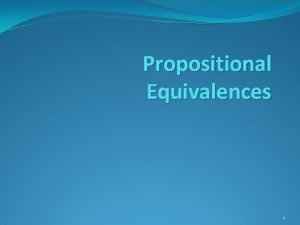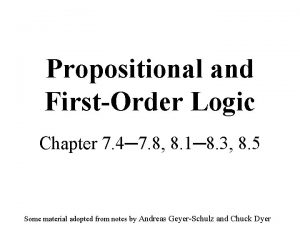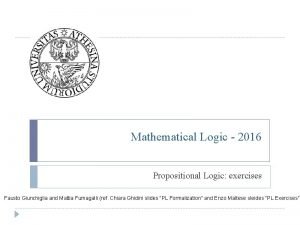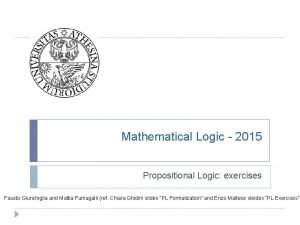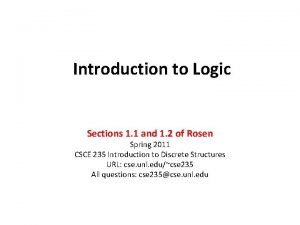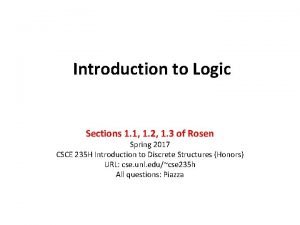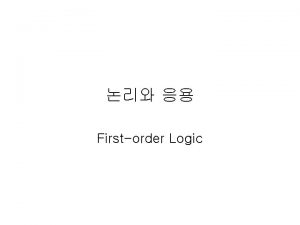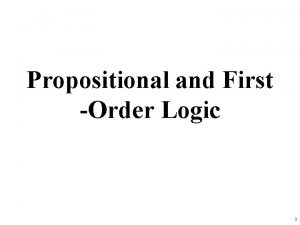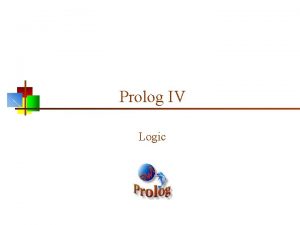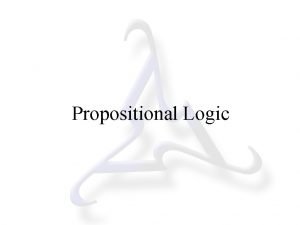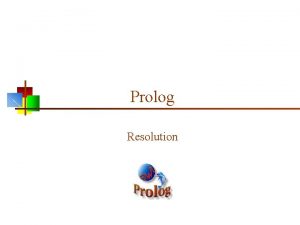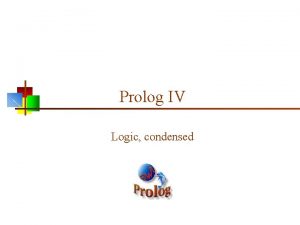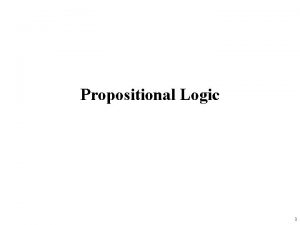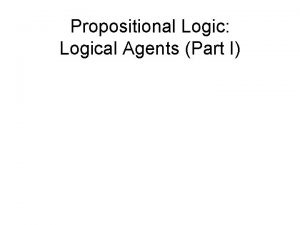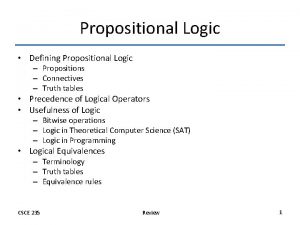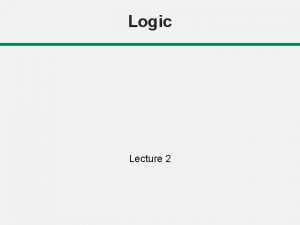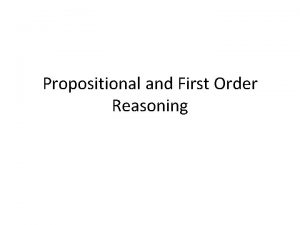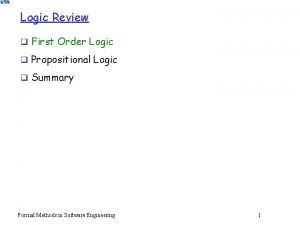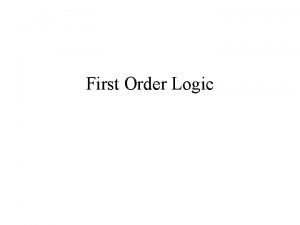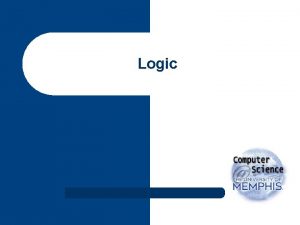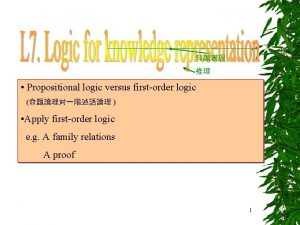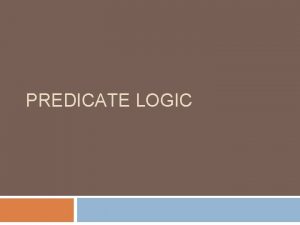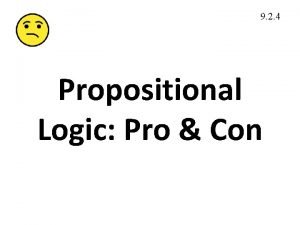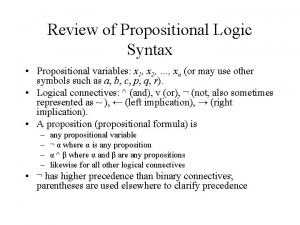FIRST AND HIGHER ORDER LOGIC LIMITATIONS OF PROPOSITIONAL


































- Slides: 34

FIRST AND HIGHER ORDER LOGIC

LIMITATIONS OF PROPOSITIONAL LOGIC Every MUET student must study discrete mathematics Ali is a MUET student So Ali must study discrete mathematics This idea can’t be expressed with propositional logic What propositional logic allows to express: If Ali is a MUET student he must study discrete mathematics Ali is a MUET student So Ali must study discrete mathematics

PROPOSITIONS ARE NOT ENOUGH TO DESCRIBE PROPERTIES AND ITS RELATED SPECS

PREDICATE LOGIC Predicate logic or predicate calculus allows us to reason about properties of objects and relationships between objects. In predicate calculus, we use predicates to express properties of objects. So the sentence “I like London” might be expressed as Like(me, London) We can now represent the sentence “It is raining in London” as well Raining(London) Similarly, ¬Raining(London) would indicate it is not raining in London.

FIRST ORDER LOGIC OR FIRST ORDER PREDICATE LOGIC First-order logic (FOL) models the world in terms of Objects, which are things with individual identities Properties of objects that distinguish them from other objects Relations that hold among sets of objects Functions, which are a subset of relations where there is only one “value” for any given “input” Examples: Objects: Students, lectures, companies, cars. . . Relations: Brother-of, bigger-than, outside, part-of, has-color, occurs-after, owns, visits, precedes, . . . Properties: blue, oval, even, large, . . . Functions: father-of, best-friend, second-half, one-more-than. . .

USER PROVIDES Constant symbols, which represent individuals in the world Mary 3 Green Function symbols, which map individuals to individuals father-of(Mary) = John color-of(Sky) = Blue Predicate symbols, which map individuals to truth values greater(5, 3) green(Grass) color(Grass, Green)

FOL PROVIDES Variable symbols E. g. , x, y, foo Connectives Same as in PL: not ( ), and ( ), or ( ), implies ( ), if and only if (biconditional ) Quantifiers Universal x or (Ax) Existential x or (Ex)

SENTENCES ARE BUILT FROM TERMS AND ATOMS A term (denoting a real-world individual) is a constant symbol, a variable symbol, or an n-place function of n terms. x and f(x 1, . . . , xn) are terms, where each xi is a term. A term with no variables is a ground term An atomic sentence (which has value true or false) is an n-place predicate of n terms A complex sentence is formed from atomic sentences connected by the logical connectives: P, P Q, P Q where P and Q are sentences quantified sentence adds quantifiers and A well-formed formula (wff) is a sentence containing no “free” variables. That is, all variables are “bound” by universal or existential quantifiers. ( x)P(x, y) has x bound as a universally quantified variable, but y is free.

QUANTIFIERS Universal quantification ( x)P(x) means that P holds for all values of x in the domain associated with that variable E. g. , ( x) dolphin(x) mammal(x) Existential quantification ( x)P(x) means that P holds for some value of x in the domain associated with that variable E. g. , ( x) mammal(x) lays-eggs(x) Permits one to make a statement about some object without naming it

QUANTIFIERS CONTD. “Every person is nice” can be rephrased as “For any thing, if it is a person, then it is nice. ” P(x) ≔ “x is a person” Q(x) ≔ “x is nice” the statement can be symbolized as For any thing, if it is a person, then it is nice x [ P(x) Q(x) ] “All persons are nice” or “Each person is nice” will also have the same symbolic formula. always related with (implication) “There is a nice person” can be rewritten as “There exists something that is both a person and nice. ” In symbolic form, ( x)[P(x) Λ Q(x)]. Variations: “Some persons are nice” or “There are nice persons. ” always related with Λ (conjunction)

QUANTIFIERS CONTD. Universal quantifiers are often used with “implies” to form “rules”: ( x) student(x) smart(x) means “All students are smart” Universal quantification is rarely used to make blanket statements about every individual in the world: ( x)student(x) smart(x) means “Everyone in the world is a student and is smart” Existential quantifiers are usually used with “and” to specify a list of properties about an individual: ( x) student(x) smart(x) means “There is a student who is smart” A common mistake is to represent this English sentence as the FOL sentence: ( x) student(x) smart(x) But what happens when there is a person who is not a student?

QUANTIFIER SCOPE Switching the order of universal quantifiers does not change the meaning: ( x)( y)P(x, y) ↔ ( y)( x) P(x, y) Similarly, you can switch the order of existential quantifiers: ( x)( y)P(x, y) ↔ ( y)( x) P(x, y) Switching the order of universals and existentials does change meaning: Everyone likes someone: ( x)( y) likes(x, y) Someone is liked by everyone: ( y)( x) likes(x, y)

CONNECTIONS BETWEEN UNIVERSAL AND EXISTENTIAL QUANTIFIER We can relate sentences involving and using De Morgan’s laws: ( x) P(x) ↔ ( x) P(x) ( x) P ↔ ( x) P(x) ( x)P(x) ↔ ( x) P(x) ↔ ( x) P(x)

QUANTIFIED INFERENCE RULES Universal instantiation x P(x) P(A) Universal generalization P(A) P(B) … x P(x) Existential instantiation x P(x) P(F) Existential generalization P(A) x P(x) skolem constant F

UNIVERSAL INSTANTIATION (A. K. A. UNIVERSAL ELIMINATION) If a bird can fly in any weather, then it can fly when it rains x: weather bird_can_fly(x) For every weather – bird can fly bird_can_fly(rains) bird can fly when it rains If there is a key for every lock, then there is a key for a particular lock. x: lock, exist_key(x) For every lock – exists a key exist_key(lab 3) key exists for "this" lock.

UNIVERSAL GENERALIZATION If "byte is 8 bits of ordered information", then any 8 ordered bits of information are a byte. is_byte(x) byte – 8 bits of ordered information x: 8 -bits, is_byte(x) any 8 ordered bits of information – byte.

EXISTENTIAL INSTANTIATION (A. K. A. EXISTENTIAL ELIMINATION) From (Ǝx) P(x) infer P(c) If a valid password exists for some UNIX system, then you can access that UNIX system with a particular password. Ǝx: password, can_log_in(x) exists a password – to log in can_log_in(c) you can log in with some particular password. If a proof for the Pythagorean theorem exists, then the Pythagorean theorem can be proved. Ǝx: proof, pythagorean_theorem(x) - exists a proof for Pythagorean theorem pythagorean_theorem(c) a particular proof can be used to do it.

EXISTENTIAL GENERALIZATION (A. K. A. EXISTENTIAL INTRODUCTION) If P(c) is true, then (Ǝx) P(x) is inferred. If an engine runs on gas, then there exists a fuel on which the engine runs. (if it’s not broken) engine_runs_on(gas) engine – runs on gas (set – fuels) Ǝx: fuel, engine_runs_on(x) exists a fuel to run engine If you can access a UNIX system with a particular password, then a valid password exists for that UNIX machine. can_access_Unix(c) can access UNIX machine Ǝx: password, can_access_unix(x) exists a password for it (unless you hack in) Note that the variable symbol cannot already exist anywhere in the expression

TRANSLATING ENGLISH TO FOL Every gardener likes the sun. You can fool some of the people all of the time. You can fool all of the people some of the time. All purple mushrooms are poisonous. No purple mushroom is poisonous. There are exactly two purple mushrooms. Clinton is not tall. X is above Y iff X is on directly on top of Y or there is a pile of one or more other objects directly on top of one another starting with X and ending with Y.

TRANSLATING ENGLISH TO FOL Every gardener likes the sun. x gardener(x) likes(x, Sun) You can fool some of the people all of the time. x t person(x) time(t) can-fool(x, t) You can fool all of the people some of the time. x t (person(x) time(t) can-fool(x, t)) x (person(x) t (time(t) can-fool(x, t)) All purple mushrooms are poisonous. x (mushroom(x) purple(x)) poisonous(x)

TRANSLATING ENGLISH TO FOL No purple mushroom is poisonous. �� x purple(x) �mushroom(x) �poisonous(x) � x (mushroom(x) �purple(x)) �� poisonous(x) There are exactly two purple mushrooms. � x� y mushroom(x) �purple(x) �mushroom(y) �purple(y) ^ � (x=y) �� z (mushroom(z) �purple(z)) �((x=z) � (y=z)) Clinton is not tall. � tall(Clinton) X is above Y iff X is on directly on top of Y or there is a pile of one or more other objects directly on top of one another starting with X and ending with Y. � x� y above(x, y) ↔ (on(x, y) �� z (on(x, z) �above(z, y)))

EXAMPLE: A SIMPLE GENEALOGY KB BY FOL Build a small genealogy knowledge base using FOL that contains facts of immediate family relations (spouses, parents, etc. ) and definitions of more complex relations (ancestors, relatives) is able to answer queries about relationships between people Predicates: parent(x, y), child(x, y), father(x, y), daughter(x, y), etc. spouse(x, y), husband(x, y), wife(x, y) ancestor(x, y), descendant(x, y) male(x), female(y) relative(x, y)

EXAMPLE: A SIMPLE GENEALOGY KB BY FOL Facts: husband(Joe, Mary) spouse(John, Nancy), male(John), son(Mark, Nancy), son(Fred, John) father(Jack, Nancy), daughter(Linda, Jack) daughter(Liz, Linda), etc.

Rules for genealogical relations ( x, y) parent(x, y) ↔ child (y, x) ( x, y) father(x, y) ↔ parent(x, y) male(x) (similarly for mother(x, y)) ( x, y) daughter(x, y) ↔ child(x, y) female(x) (similarly for son(x, y)) ( x, y) husband(x, y) ↔ spouse(x, y) male(x) (similarly for wife(x, y)) ( x, y) spouse(x, y) ↔ spouse(y, x) (spouse relation is symmetric)

(� x, y) parent(x, y) �ancestor(x, y) (� x, y)(� z) parent(x, z) �ancestor(z, y) �ancestor(x, y) (� x, y) descendant(x, y) ↔ ancestor(y, x) (� x, y)(� z) ancestor(z, x) �ancestor(z, y) �relative(x, y) (related by common ancestry) (� x, y) spouse(x, y) �relative(x, y) (related by marriage) (� x, y)(� z) relative(z, x) �relative(z, y) �relative(x, y) (transitive) (� x, y) relative(x, y) ↔ relative(y, x) (symmetric)

Queries ancestor(Jack, Fred) /* the answer is yes */ relative(Liz, Joe) relative(Nancy, Matthew) /* no answer in general, no if under closed world assumption */ (� z) ancestor(z, Fred) �ancestor(z, Liz) /* the answer is yes */

SEMANTICS OF FOL Domain M: the set of all objects in the world (of interest) Interpretation I: includes Assign each constant to an object in M Define each function of n arguments as a mapping Mn => M Define each predicate of n arguments as a mapping Mn => {T, F} Therefore, every ground predicate with any instantiation will have a truth value In general there is an infinite number of interpretations because |M| is infinite Define logical connectives: ~, ^, v, =>, <=> as in PL Define semantics of ( x) and ( x) P(x) is true iff P(x) is true under all interpretations ( x) P(x) is true iff P(x) is true under some interpretation

CONTD. Model: an interpretation of a set of sentences such that every sentence is True A sentence is satisfiable if it is true under some interpretation valid if it is true under all possible interpretations inconsistent if there does not exist any interpretation under which the sentence is true Logical consequence: S |= X if all models of S are also models of X

AXIOMS, DEFINITION AND THEOREMS Axioms are facts and rules that attempt to capture all of the (important) facts and concepts about a domain; axioms can be used to prove theorems Mathematicians don’t want any unnecessary (dependent) axioms –ones that can be derived from other axioms Dependent axioms can make reasoning faster, however Choosing a good set of axioms for a domain is a kind of design problem A definition of a predicate is of the form “p(X) ↔ …” and can be decomposed into two parts Necessary description: “p(x) …” Sufficient description “p(x) …” Some concepts don’t have complete definitions (e. g. , person(x))

MORE ON DEFINITIONS Examples: define father(x, y) by parent(x, y) and male(x) parent(x, y) is a necessary (but not sufficient) description of father(x, y) parent(x, y) ^ male(x) ^ age(x, 35) is a sufficient (but not necessary) description of father(x, y): father(x, y) parent(x, y) ^ male(x) ^ age(x, 35) parent(x, y) ^ male(x) is a necessary and sufficient description of father(x, y) parent(x, y) ^ male(x) ↔ father(x, y)

S(x) is a necessary condition of P(x) S(x) is a sufficient condition of P(x) S(x) is a necessary and sufficient condition of P(x) S(x) P(x) S(x) ( x) P(x) => S(x) ( x) P(x) <=> S(x) MORE ON DEFINITIONS

HIGHER ORDER LOGIC FOL only allows to quantify over variables, and variables can only range over objects. HOL allows us to quantify over relations Example: (quantify over functions) “two functions are equal iff they produce the same value for all arguments” f g (f = g) ( x f(x) = g(x)) Example: (quantify over predicates) r transitive( r ) ( xyz) r(x, y) r(y, z) r(x, z))

EXPRESSING UNIQUENESS Sometimes we want to say that there is a single, unique object that satisfies a certain condition “There exists a unique x such that king(x) is true” x king(x) y (king(y) x=y) x king(x) y (king(y) x y) ! x king(x) “Every country has exactly one ruler” Iota operator: “ x P(x)” means “the unique x such that p(x) is true” c country(c) ! r ruler(c, r) “The unique ruler of Freedonia is dead” dead( x ruler(freedonia, x))

THANK YOU
 First order logic vs propositional logic
First order logic vs propositional logic First order logic vs propositional logic
First order logic vs propositional logic First order logic vs propositional logic
First order logic vs propositional logic Compound proposition
Compound proposition Fol in ai
Fol in ai Pros and cons of propositional logic
Pros and cons of propositional logic Translation
Translation Propositional logic examples and solutions
Propositional logic examples and solutions Arguments in logic
Arguments in logic Xor in propositional logic
Xor in propositional logic Proposition in mathematics
Proposition in mathematics Xor in propositional logic
Xor in propositional logic Propositional logic notation
Propositional logic notation Implies in propositional logic
Implies in propositional logic Prolog resolution
Prolog resolution Propotional logic dapat digunakan untuk
Propotional logic dapat digunakan untuk Inverse implication
Inverse implication Contradiction formula
Contradiction formula Logic
Logic Discrete math propositional logic
Discrete math propositional logic Applications of propositional logic in discrete mathematics
Applications of propositional logic in discrete mathematics P double implies q
P double implies q The proposition ~p ν (p ν q) is a
The proposition ~p ν (p ν q) is a Reflexive axiom
Reflexive axiom Fluent7
Fluent7 Valid arguments in propositional logic
Valid arguments in propositional logic Parse tree propositional logic
Parse tree propositional logic Tautological equivalence
Tautological equivalence Propositional logic signs
Propositional logic signs Propositional logic exercises
Propositional logic exercises Propositional logic exercises
Propositional logic exercises Proposition and not proposition
Proposition and not proposition Logical connectives
Logical connectives Propositional logic
Propositional logic Kinship domain in artificial intelligence
Kinship domain in artificial intelligence



